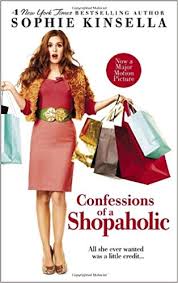The False Promise of Confessions of a Shopaholic
If She could be Saved; then so am I!

Every girl loves to shop.
I mean it, women who deny their urge to shop are denying themselves a cosmic pleasure, a call of the wild, a mesmerizing power beyond their ability to fathom or grasp. It doesn’t have to be shoes or lipstick, it can be a utensil or a house appliance or even a new Coursera specialization. It’s not gender-based assembly nor a categorization based on our vaginal cravings but more of the need to own. In a male-dominant world where women fought for their right to own lands or have their own bank accounts; shopping became their way of building a materialistic empire where things are their own, and not their husbands’ or children’s.
I am a shopaholic, a shopping addict, a shopping-phile, someone with compulsive buying disorder. I mean I revel in the beauty of consumer goods. Kylie Jenner’s newest lip shade. Sign me up please. Is this a pharmacy? Let me flip through all the OTC cough syrups and sore throat lozenges. I hear the names of brands like Prada, Christian Louboutin, Chanel, Dior, and my heart starts pumping blood faster to the rest of the organs.
Let’s hope it won’t give up on me for the sake of a brand.
I enter a shoe shop and suddenly my boots feel tighter, my stilettos clumsier and all those earrings on the holder stand seem more exciting and strangely different than the ones at home safe and sound in my jewelry box. A perfume shop meant that I stank and was immediately in need of a new bottle, preferably with the accompanying shower gel and bubble bath.
I am a daughter of the consumerist culture of the 1980s-1990s, where American globalization invaded everything. I listened to American music, watched American movies only –unlike my parents who were exposed to Indian, Italian and French cultures- and ate American foods wrapped in cartons or reciprocated through brand franchises opening in my homecountry. I became a slave of the American propaganda machine. It all went well with me and my salary until the Egyptian economic crisis in 2016.
As found in infomineo.com;
On November 3rd, 2016, the Central Bank of Egypt floated the Egyptian pound in an attempt to stabilize the economy which had been set back by a shortage of foreign currency inflows and political instability.
Blah blah blah
By that time, the devaluation prices were already adjusted/adjusting to the price of the black market which was around the same price after the devaluation. So, at the floatation period, prices increased but not by the same value the pound depreciated.
Ahem, whatever you’re saying!
The government also began to restructure its subsidy program. A five-year energy subsidy reform program began in 2014 aiming at stopping energy subsidies by 2019. Electricity prices increased by 25-40% depending on usage in August 2016. In July 2017, Electricity prices increased again by 15-42% for domestic use and by 29-46% for the commercial Sector. Fuel prices increased 2 times since floatation. The government is moving into a cash-based subsidy system, where the less fortunate get their subsidies in cash, rather than subsidizing food commodities and fuel for all.
Dude, calm down!
This step led prices to increase gradually in the months that preceded the devaluation because most businesses priced their products according to the value of dollars they import with, which was mostly obtained through the black market as 90 percent of imported consumer goods were already being paid for at black market currency rates in the months before the devaluation.
For a middle-class consumerist gal like me, all hell broke loose. Brand shops closed their doors in small cities like mine (still present in the capital; Cairo, though), everything became insanely unaffordable. I began to take back every word I said about using imported goods, brands were out of the question. Local merchandise started looking like a not-so-bad idea.
But something in me died. The fact that I could not afford what I craved. The fact that I had to sacrifice quality for short half-life. Local merchandise lacked the luster and galore of branded items. I kept scouting shops for discounts but still, nothing. The fact hit me that I went down in the social status ladder and I either…let my wild side loose and ran to the woods, unrelenting and unapologetic, or I succumb to the reality of the situation. Yes, nobody dies from loving things they can’t afford.
Enter Rebecca Bloomwood.
Like me she is a shopping addict. Like me her finances are oozing with messes and shortcomings. Like me, she finds a cashmere sweater more fulfilling than a man. Like me she is a good writer who is distracted by multiple, materialistic unsated needs. Like her, I need to focus on feelings that have nothing to do with film criticism to write an impressive essay.
I love “Confessions of a Shopaholic”.
I’m a major film buff. My favorite directors are Jarmusch, Varda, Kar-wai, Ozon, Campion and Farhadi. I have my guilty pleasures but they are somewhat thoughtful chick-flicks mostly written by legends such as Nora Ephron and Nancy Meyers.
But this…
Confessions of a Shopaholic is admittedly a mess. It’s a shortcut between “Legally Blonde” and “Sex and the City”. It does not understand its tone and it contains multiple scenes where people stare intentionally at each other just to pluck laughs from our decaying wisdom teeth.
Still it’s a lovely mess, while it lacks the glam of Sex and the City, and Isla Fisher is by no means the next Reese Witherspoon, it serves its purpose. There are brands thrown around. There’s a quirky, clumsy female protagonist who beats the evil icy, Hitchcockian blond. The film is empowering in one of its aspects; talent saves. A gal can be saved if she put her focus on talent rather than needs. Miss Blomwood did what I practice on a daily basis; write about my pain, my frustration, how the pain and stability of the routine of an everyday fulltime job positively influenced me.
Then what went wrong?
While a movie like Legally Blonde creates a character that people can look up to and admire, “Confessions of a Shopaholic” throws a blatant character sketch that has no meat to it. There’s nothing beyond what Rebecca offers at the moment. I have read all the Sophie Kinsella novels and would have loved a sequel or two. But even with the multiple situations in which Rebecca could have infused her quirky, clumsy character into, translating that on the big screen would have proved a failure.
Rebecca Blomwood has no power or glamour beyond the name tag she’s wearing. Her clothes have not been recognized as major fashion moments in film. None of her shoes or outfits risk being iconized as one of Carrie Bradshaw’s multiple faux and triumphs in the world of fabric.
So if it is that forgettable, why am I crazily in love with it?
Because it represents a part of me that has not died yet. Like Rebecca I am dreaming of the ultimate time when I feel satisfied after shopping and the urge dies. Because Rebecca is that silly, teenage girl, in awe of an all-American life and the American teenage heartthrobs who appear onscreen and like Fluke whisk a girl off her feet into an enchanted castle of…well, in her case endless shopping frenzies where she might eventually seek that satisfaction she’s blindly after.
At the end of the movie, like every other quirky, Hollywood-polished American tale, Rebecca is saved. She gets back her guy, her BFF, her family backs her up, even her green scarf, and yet, we are left with the big uncertainty; are the winking shopping mannequins saluting her for abandoning the raging waves of the internal sea that would subside soon; a.k.a ripping off the shopping junkie tag, or are they whispering in her ears to lay her tiredness and her huddled messes yearning to breathe free. Was the ending a resolution or an absolution?
For me, it did not create that big of a difference. Loving Rebecca was enough. Her triumph on the big screen was enough for me to be certain that maybe –just maybe I could also be saved from myself. Credit card debt aside!

